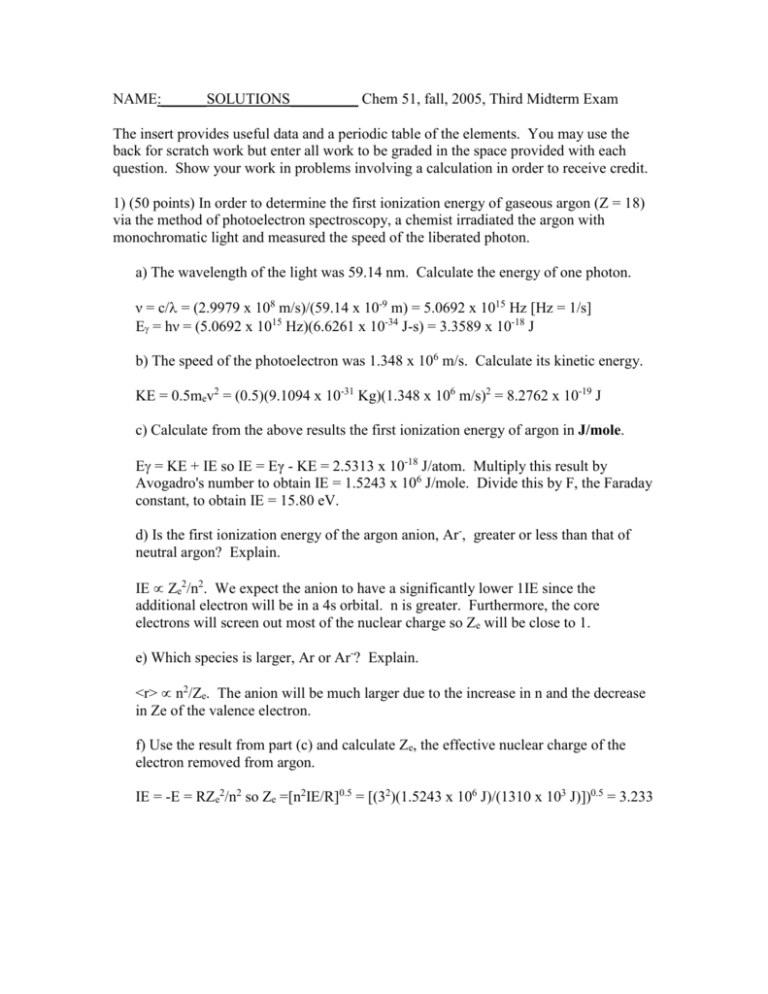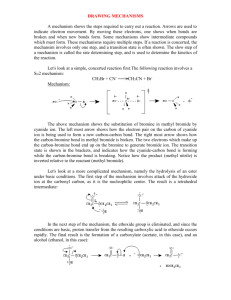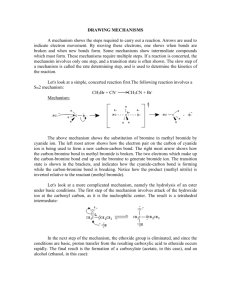USEFUL CONSTANTS
advertisement

NAME:______SOLUTIONS_________ Chem 51, fall, 2005, Third Midterm Exam The insert provides useful data and a periodic table of the elements. You may use the back for scratch work but enter all work to be graded in the space provided with each question. Show your work in problems involving a calculation in order to receive credit. 1) (50 points) In order to determine the first ionization energy of gaseous argon (Z = 18) via the method of photoelectron spectroscopy, a chemist irradiated the argon with monochromatic light and measured the speed of the liberated photon. a) The wavelength of the light was 59.14 nm. Calculate the energy of one photon. ν = c/ = (2.9979 x 108 m/s)/(59.14 x 10-9 m) = 5.0692 x 1015 Hz [Hz = 1/s] E = hν = (5.0692 x 1015 Hz)(6.6261 x 10-34 J-s) = 3.3589 x 10-18 J b) The speed of the photoelectron was 1.348 x 106 m/s. Calculate its kinetic energy. KE = 0.5mev2 = (0.5)(9.1094 x 10-31 Kg)(1.348 x 106 m/s)2 = 8.2762 x 10-19 J c) Calculate from the above results the first ionization energy of argon in J/mole. E = KE + IE so IE = Eγ - KE = 2.5313 x 10-18 J/atom. Multiply this result by Avogadro's number to obtain IE = 1.5243 x 106 J/mole. Divide this by F, the Faraday constant, to obtain IE = 15.80 eV. d) Is the first ionization energy of the argon anion, Ar-, greater or less than that of neutral argon? Explain. IE Ze2/n2. We expect the anion to have a significantly lower 1IE since the additional electron will be in a 4s orbital. n is greater. Furthermore, the core electrons will screen out most of the nuclear charge so Ze will be close to 1. e) Which species is larger, Ar or Ar-? Explain. <r> n2/Ze. The anion will be much larger due to the increase in n and the decrease in Ze of the valence electron. f) Use the result from part (c) and calculate Ze, the effective nuclear charge of the electron removed from argon. IE = -E = RZe2/n2 so Ze =[n2IE/R]0.5 = [(32)(1.5243 x 106 J)/(1310 x 103 J)])0.5 = 3.233 2) (50 points) Two isomers with the stoichiometry CH3NO2 are known: methyl nitrite with the connectivity H3CONO and nitromethane with the connectivity H3CNO2. a) Draw electron-dot structures of the two isomers. Include resonance structures as appropriate. Provide the formal charges and the hybridization of the heavy, i.e. non-hydrogen, atoms. CH3ONO, C & O adjacent to C, sp3;N & other O, sp2; formal charge on all atoms is 0. CH3NO2, C, sp3; all others, sp2; formal charge: 0 on C and doubly bonded O, +1 on N and -1 on the singly bonded O. b) Compare the nitrogen-oxygen bond lengths of the two isomers. Discuss the basis for your order. One electron-dot structure is possible for methyl nitrite with a N,O single bond and a N,O double bond. The former is shorter. We note two resonance structures in the case of nitromethane so the N,O bond length is halfway between a single and double bond. rN=O(methyl nitrite) < rN,O(nitromethane) < rN-O(methylnitrite) c) Predict the CON and ONO bond angles in methyl nitrite. There are 4 groups of charge around the O connected by single bonds to the N and C. Don't overlook the lone pairs! Therefore tetrahedral geometry with CON 109. In contrast, there are 3 groups of charge around the nitrogen so trigonal planar geometry with ONO 120 is expected. d) In which isomer would you expect all the heavy atoms to lie in the same plane? Nitromethane is a sure winner. The oxygen atoms and the carbon atom are directly attached to the nitrogen atom which has 3 groups of charge around it and therefore a trigonal planar geometry. All 4 atoms must therefore lie in the same plane. e) Which isomer might exhibit conformers? Briefly explain. Methyl nitrite. Rotation about the N,O single bond will involve small changes in energy as bond breaking is not involved. Two distinct species with the N=O group cis and trans to the methyl (CH3) group are possible. 3) (35 points) Transition-metal elements exhibit variable valence because of d electrons. VF3 melts at 1400C and VF5 at 15C. Discuss thoroughly the basis for this striking difference. The striking difference in melting points, very high for VF3 and very low for VF5, clearly indicates a difference in bonding. VF3 exhibits ionic bonding and VF5, covalent. Ionic bonding in the case of VF5 is unlikely because the energetic cost for the removal of all 5 valence electrons is too high. The ionic nature of VF3 indicated by its high melting point indicates that the cost of removing 3 rather than 5 valence electrons is not too high and is compensated by a large Coulombic attraction resulting from the high charge and the small size of the V+3 cation. 4) (15 points) Two perspectives of the same hydrogen orbital are given below. Left: the z axis is perpendicular to the page. Right: it is in the page and is oriented vertically. a) Determine the values of the quantum numbers l and |ml| of this orbital. b) What is the minimum possible value of n for an electron in this type of orbital? c) Calculate in units of h/2π the value of the orbital angular momentum L of an electron in this orbital. d) Will an electron in this orbital ever be found at or close to the nucleus? Explain. a) Note two angular nodes so l =2. Both nodes contain the z axis so |ml| = 2. b) For each value of n, l ranges from 0 to n - 1 so n(minimum) = 3. c) L = [l(l + 1)]0.5(h/2π) = [2(3)]0.5 h/2π = [6]0.5 h/2π d) No. First, the two angular nodes intersect at the nucleus so = 0 at the nucleus. Secondly, the large centrifugal force resulting from the orbital angular momentum will force the electron away from the near vicinity of the nucleus.






